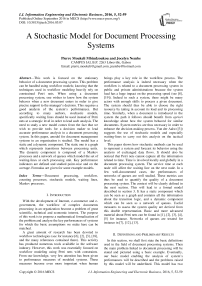A Stochastic Model for Document Processing Systems
Автор: Pierre Moukeli Mbindzoukou, Jocelyn Nembe
Журнал: International Journal of Information Engineering and Electronic Business(IJIEEB) @ijieeb
Статья в выпуске: 5 vol.8, 2016 года.
Бесплатный доступ
This work is focused on the stationary behavior of a document processing system. This problem can be handled using workflow models; knowing that the techniques used in workflow modeling heavily rely on constrained Petri nets. When using a document processing system, one wishes to know how the system behaves when a new document enters in order to give precise support to the manager's decision. This requires a good analysis of the system's performances. But according to many authors, stochastic models, specifically waiting lines should be used instead of Petri nets at a strategic level in order to lead such analysis. The need to study a new model comes from the fact that we wish to provide tools for a decision maker to lead accurate performance analysis in a document processing system. In this paper, amodel for document management systems in an organization is studied. The model has a static and a dynamic component. The static one is a graph which represents transitions between processing units. The dynamic component is composed of a Markov processes and a network of queues which model the set of waiting-lines at each processing unit. Key performance indicators are defined and studied point-wise and on the average. Formulas are given for some example models.
Document processing, workflow, counting processes, stochastic models, waiting lines, Markov processes
Короткий адрес: https://sciup.org/15013479
IDR: 15013479
Список литературы A Stochastic Model for Document Processing Systems
- van der Aalst W.M.P., Basten T., Verbeek H.M.W., Verkoulen P.A.C., Voorhoeve M.: Adaptive workflow, on the interplay between flexibility and support. 1998, http://www.win.tue.nl/ hverbeek/downloads/preprints/Aalst99.pdf
- van der Aalst W.M.P., van Hee K.: Workflow management models, methods and systems. Book, w.m.p.v.d.aalst@tm.tue.nl, kvanhee@deloitte.nl, http://wwwis.win.tue.nl/ wvdaalst/publications/p120.pdf
- van der Aalst W. M. P., van Hee K. M., terHofstede A. H. M., Sidorova N., Verbeek H. M. W., Voorhoeve M., Wynn M. T.: Soundness of workflow nets: classification, decidability, and analysis. Formal Aspect of Computing, 2011, 23:333-363, http://alexandria.tue.nl/repository/books/636105.pdf
- Abbott K.R., Sarin S.K.: Experiences with workflow management: issues for the next generation. kabbott:osbunorth@xerox:com, proceeding of CSCW 94 Proceedings of the 1994 ACM conference on Computer supported cooperative work, Pages 113-120, http://www:gerrystahl:net/teaching/winter12/Abbottworkflow:pdf
- Bauereiss T., Hutter D.: Possibilistic information flow control for workflow management systems. Proceedings GraMSec 2014, arXiv:1404.1634
- Chang J., Blei D.M.: Hierarchical relational model for document nNetworks. The Annals of Applied Statistics, 2010, Vol. 4, No. 1, 124150, Euclid.aoas
- Chen H., Yao D.: Fundamentals of queuing networks: performance, asymptotic and optimization. Springer, 2001. ISBN 0-387-95166-0
- Deelman E., Gannon D., Shields M., Taylor I.: Workflows and e-Science: an overview of workflow system features and capabilities, Future Generation Computer Systems (2008), doi:10.1016/j.future.2008.06.012
- Forsati R., Mahdavi M., Shamsfard M., Meybodi M.R.: Efficient stochastic algorithms for document clustering. Information Sciences, Volume 220, 20 January 2013, Pages 269291
- Georgakopoulos D., Hornick M., Sheth A.: An overview of workflow management from process modeling to workflow automation infrastructure. Distributed and Parallel Databases, 3, 119-153, 1995
- Glatard T., Montagnat J., Lingrand D., Pennec X.: Flexible and efficient workflow deployment of data-intensive applications on grids with MOTEUR. International Journal of High Performance Computing and Applications, Volume 22 Issue 3, August 2008, Pages 347-360
- Gross D., Carl M. Harris: Fundamentals of queuing theory. Wiley, 1998. ISBN 0-471-32812-X
- Lazowska, Edward D., John Zahorjan, G. Scott Graham, Kenneth C. Sevcik: Quantitative system performance:computersystem analysis using queuing network models. Prentice-Hall, Inc. 1984. ISBN 0-13-746975-6
- Gottschalk F., van der Aalst W.M.P., Jansen-Vullers M.H., La Rosa M.: Configurable workflow models. International Journal of Cooperative Information Systems, March 10, 2008
- Pandey S., Wu L., Mayura Guru S., Buyya R.: A particle swarm optimization-based heuristic for scheduling workflow applications in cloud computing environments, 2010, Cloud Computing and Distributed Systems Laboratory; Department of Computer Science and Software Engineering; The University of Melbourne, Australia;{spandey, linwu, raj}@csse.unimelb.edu.au
- Pesic M., Schonenberg M.H., Sidorova N., van der Aalst W.M.P.: Constraint-based workflow models: change made easy. m.pesic, m.h.schonenberg, n.sidorova, w.m.p.v.d.aalst@tue.nl
- McPhillips T., Bowers S., Zinn D., Ludscher B.: Scientific workflow design for mere mortals. Future Generation Computer Systems, 2008
- Shi M., Yang G., Xiang Y., Wu S.: Workflow management systems: asurvey. Proceedings of IEEE Intl Conf on Communication Technology, Beijing:, Oct, 1998. shi, ygxin, xyong, wsg@csnet4.cs.tsinghua.edu.cn
- Simmhan Y. L., Plale B., Gannon D.: Performance evaluation of the Karma provenance framework for scientific workflows. International Provenance and Annotation, Workshop (IPAW), Springer, Berlin, 2006
- Singer R., Kotremba J., Ra S., Joanneum F.: Modeling and execution of multi-enterprise business processes. University of Applied Sciences, 2 Str ICT Solutions GmbH.
- White S. A.: Process modeling notations and workflow patterns. IBM Corporation, BP Trends, March, 2004, www.bptrends.com
- Zhang J., Kuc D., Lu S. Confucius: atool supporting collaborative scientific workflow composition. IEEE, Transactions on Services Computing, VOL.PP, NO.99, 2012


